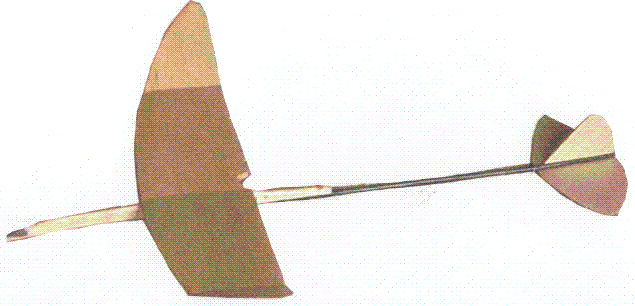Most modern glider designs today include the use of carbon fiber, typically in the fuselages and sometimes in the wings. The stiffness/weight of the model can be increased by using carbon fiber. It only adds a little weight, but this is the main reason carbon fiber is used. In gliders, stiffness is needed to obtain good height. Weight needs to be minimized to obtain a good sink rate.
In the design and optimization of any object (like a glider) the first thing one must understand is if the object will break when it is being pushed to the limits, or the object will deflect so much that it will not be able to perform. This translates in engineering terms: Is the object stress limited or modulus limited?
In designing a glider, the main problem is deflection limitation. If you are careful and slowly add power to each launch of a well trimmed out model, you will find that at some point, more power actually reduces the launch height. At this point, you have reached the limit where the model is deflecting so much that the launch height will be compromised. By adding more power, after you reached this point, the model will break or fail.
Now back to basic engineering principles, if the problem is stress limited then the ultimate strength of the material is important. If it is deflection limited then Young’s Modulus is important. We are interested in these properties per some weight or density. For example if a material is very stiff but adds excessive weight, it won't be much help to the stiffness/weight ratio.
Here are some materials and their properties:

Note: I listed many different types of carbon fiber. The first two are PAN fibers(IM7 and M46J) and the last two are PITCH fibers.
Pitch fiber is much more expensive and harder to work with than PAN fiber. PAN fiber is typically used in golf clubs etc. PITCH fiber is what some satellites are made of. Most model suppliers are selling PAN fiber.
More information about carbon fiber needs to be known. Carbon fiber should be thought of as a thread or rope. The term carbon tow is used instead of carbon thread. Now in order for the carbon tow to become a part or object some glue is added to bond many tow together. The glue and carbon fiber part is then referred to as a carbon fiber composite. This is a very simple, two part composite. More complicated composites can also be made where three or more materials are joined together to create a part or object. The strength of the simple carbon fiber composite(carbon and glue only) is a function of three factors. The first factor is what the properties (strength and modulus) of the carbon fiber and the glue are. The second factor is how the carbon fiber tow is orientated. If all the carbon tow is laid down in one direction, unidirectional parts are made. This gives you high stiffness or strength in one direction but very poor stiffness or strength in another direction. One can make quasi-isentropic material(like steel where the properties of the material are the same in all directions) by using multiple layers of this unidirectional fiber(placed at different angles with respect to the each other). This will lower the overall stiffness or strength of the part per some unit mass but now the part will be stiff in all directions. The last factor that influences the stiffness or strength is the amount of each material(glue and carbon fiber) used in the composite. Since carbon fiber is very stiff/strong compared to glue, the less glue in the part the better.
Now like any thread, Carbon tow is not easy to work with and if just soaked in glue it is hard to control the amount of glue in a part. There are two common glue systems used to join the carbon tow together.
One is referred to as wet, room temperature curing system. Here room temperature curing glues are used to join the carbon tow together. If one performs this process by hand (without a machine) the amount of resin in the lay-up is very hard to control. A machine can be used to help control the amount of resin used and is also used to lay down the fiber. This process is typically referred to as a Pultrusion process. In the pultrusion process a machine wets the carbon tow and puts down the carbon fiber tow in a controlled fashion to make the part. Hand “wet” lay-ups of carbon parts can have a typically resin content of 75-60%. The pultrusion process can typically get the resin content to about 50%.
The second kind of glue system is referred to as prepreg. With this kind of glue system sheets of carbon fiber composites are made but not completely cured at a manufacturing facility again, using machines. What is typically done is, carbon tow will be laid–up into unidirectional sheets about 12” wide. Here many lengths of tow are laid down, side-by-side and held together with B-stage epoxy. B-stage epoxy is epoxy that is semi-cured, so it is sticky, soft and flexible. Now one purchases these sheets(or rolls) from a vendor and can lay them up by hand or again by a machine to create a part. To harden or cure the B-stage(also referred to as prepreg), temperature is applied, typically 350F for about 2-3 hrs. Parts made by from prepreg can be made up with as low as 20% glue by the use of an autocave. An autocave is an oven that also supplies a pressure (typically 100psi)to the part that is being cured, pushing out any excess glue. Vacuum Bagging is basically an autocave process but the pressure is limited to 15psi or full vacuum.
Many model suppliers offer carbon tow, cured unidirectional carbon fiber sheets and carbon fiber plates. Some model suppliers also sell more complicated carbon fiber composites like carbon/balsa/glue sheets and carbon/foam/glue sheets. I am not aware of any model supplier offering uncured carbon fiber prepreg. I suspect the reason is that carbon fiber prepreg does have a limited shelf life of about 1 month unless it is kept in a freezer.
Now the properties of carbon fiber supplied above does not include the epoxy need to hold all these fibers together to form an object. One needs to include in the calculated the glue to obtain the mechanical properties of the composite material or part. The table below reflexes the carbon fiber compositie material; 40% epoxy; 60% carbon fiber and only one layer of carbon tow in a unidirectional lay-up:

Now what is of most interest to us is stiffness/weight so one can calculate the ratios of these properties per the density of the material. I also divide by 1000000 to get numbers that are not so big. These numbers are only useful to compare "relative goodness". Here we are just trying to get a ratio so we can understand what material is the strongest or stiffest per weight. The larger the number in the table the better the material is in terms of Stress/weight or Stiffness/weight.

So from this table on can clearly see that adding carbon fiber to a glider design does make sense. Now there are many other factors to consider and one must really study the details to get the correct answers.

